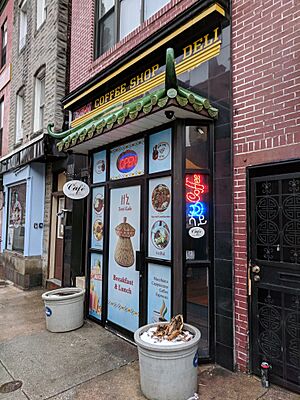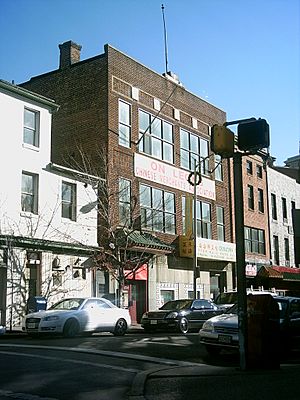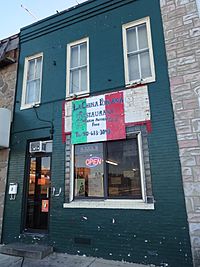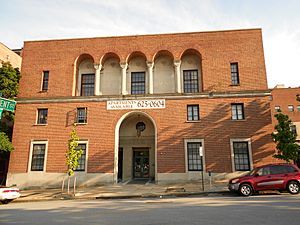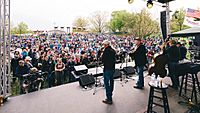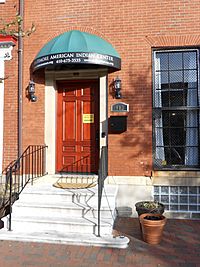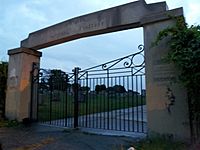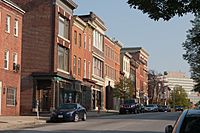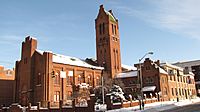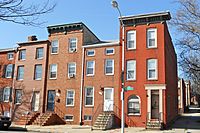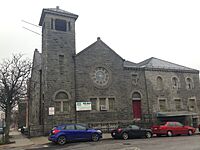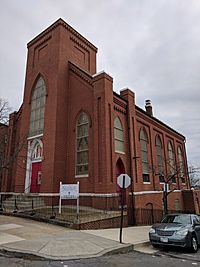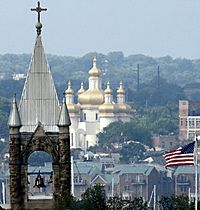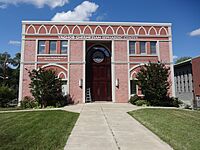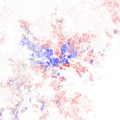Ethnic groups in Baltimore facts for kids
Baltimore, Maryland, has been a home to many different groups of people for a very long time, even for 12,000 years! Before Europeans arrived, Native American tribes lived here for almost 3,000 years. After Baltimore was founded in 1661 by British settlers, many people from Europe came, along with enslaved Africans. Over time, more people arrived from all over Europe, and a large community of free Black people grew. Later, African Americans moved here from the Southern U.S., and white people came from Appalachia. More recently, immigrants from Latin America, the Caribbean, Asia, and Africa have made Baltimore even more diverse. This mix of cultures, traditions, and languages makes Baltimore unique.
Contents
- Early History of Baltimore's People
- Diverse Communities in Baltimore
- African Americans in Baltimore
- African Immigrants in Baltimore
- Asian Americans in Baltimore
- Hispanics and Latinos in Baltimore
- Jewish Community in Baltimore
- Northern Americans in Baltimore
- Romani People in Baltimore
- Oceanian People in Baltimore
- West Indians in Baltimore
- White Americans in Baltimore
- Middle Eastern and North African People in Baltimore
- Baltimore's Population by Race (2010)
- Images for kids
Early History of Baltimore's People
The Baltimore area has been home to Native Americans since at least 10,000 BC. These early people were called Paleo-Indians. Later, different Native American groups lived here, including the Piscataway tribe.
In 1608, Captain John Smith explored the Chesapeake Bay and the Patapsco River. The name "Patapsco" comes from an Algonquian word meaning "backwater." The Chesapeake Bay was also named after a Native American tribe.
When English colonists started settling in Maryland, they traded with the Algonquians. They exchanged English cloth and tools for beaver furs. This trade was important for both groups. However, as more English farmers arrived, they took more land from Native Americans. Even though treaties were made to protect Native American rights, these agreements were often not respected. Eventually, Native Americans were moved to special areas called reservations.
In 1642, there was a war between the Maryland colony and some Native American groups, including the Susquehannocks. The Susquehannocks had guns from Swedish colonists and defeated the English. Later, in 1652, the Susquehannocks made peace with Maryland and gave up a lot of land. They also worked with the English against a common enemy, the Iroquois. This alliance lasted for 20 years, but the English did not treat the Susquehannock allies well. In 1674, the Susquehannock people were forced to move to the Potomac River.
Diverse Communities in Baltimore
Baltimore is known for its many different ethnic groups. Let's learn about some of them!
African Americans in Baltimore
African Americans are the largest group in Baltimore. Their history here goes back to the 1600s when the first enslaved Africans arrived. For most of its history, Baltimore had more white residents, but in the 1970s, African Americans became the majority. By 2010, about 63% of Baltimore's population was African American.
African Americans have greatly shaped Baltimore's culture, language, history, and music. Unlike many northern cities, Baltimore had a large community of free Black people even before the Civil War. Between 1910 and 1970, many African Americans moved to Baltimore from the Southern U.S. This made Baltimore the second northernmost city with a Black majority, after Detroit.
The African American community is mainly in West and East Baltimore. People sometimes call this pattern "The Black Butterfly." White Americans mostly live in Central and Southeast Baltimore, which is sometimes called "The White L."
African Immigrants in Baltimore
In 2010, over 28,000 immigrants from Sub-Saharan Africa lived in Baltimore. Every year, there's a festival called FestAfrica in Patterson Park. It teaches people about different African cultures and histories. About 4,000 people usually attend, enjoying food, music, and fun.
In 2011, African languages were the third most common languages spoken in Baltimore by people who didn't speak English very well. This was after Spanish and Chinese.
Ethiopians in Baltimore
Many Ethiopian Americans live in Maryland, with a large number in the Greater Baltimore area. They often own small businesses, work as cab drivers, or in healthcare. The Ethiopian Community Center in Baltimore helps Ethiopian residents with education and support.
Baltimore's historic Chinatown area now has a growing Ethiopian community. You can find Ethiopian restaurants, coffee shops, and markets there. This area is sometimes called "Little Ethiopia." In 2011, Ethiopians were the twenty-third largest group of foreign-born people in Baltimore.
Nigerians in Baltimore
Baltimore hosts an annual Nigerian festival called Naija Fest. It's put on by the Nigerian Youth Association of Maryland and features art, dance, music, and food.
In 2011, Nigerians were the sixth largest group of foreign-born people in Baltimore. This makes them the largest African immigrant group in the city. Yoruba, a language spoken in Nigeria, is the third most spoken language in Baltimore after English and Spanish. It's also the second most spoken foreign language in Baltimore schools.
Asian Americans in Baltimore
The largest Asian groups in Baltimore are Koreans and Indians. There are also smaller numbers of Filipinos, Chinese, Japanese, and Vietnamese people. Many Asian residents live near Johns Hopkins University and in Downtown Baltimore.
In 2000, there were about 9,800 Asian Americans in Baltimore. This was about 1.5% of the city's population. Asia was the second largest region for immigrants coming to Baltimore, after Latin America.
Chinese Americans in Baltimore
There have been two Chinatowns in Baltimore's history. The first one was in the 1880s. A second one was on Park Avenue, known for its laundries and restaurants. The Chinese population in Baltimore was never very large, and by the 1970s, few Chinese people lived in the city. Today, there are discussions about whether to bring back the old Chinatown or create a new one.
In 2011, immigrants from China were the fifth largest group of foreign-born people in Baltimore. Chinese was also the second most common language spoken by people who didn't speak English very well, after Spanish.
Filipino Americans in Baltimore
In 2000, about 8,500 Filipino Americans lived in the Baltimore area. The Tagalog language, spoken in the Philippines, was spoken at home by over 2,000 people in Baltimore.
An annual Philippine-American Festival is held in Towson, a suburb of Baltimore. It features Filipino food, dances, and a parade. In 2011, Filipinos were the eighth largest group of foreign-born people in Baltimore.
Indian Americans in Baltimore
About 39,000 Indian Americans live in the Baltimore area, making them the largest Asian group in Metro Baltimore.
Baltimore hosts the Rathayatra Parade, an ancient Indian festival. It starts near Oriole Park at Camden Yards and ends at the Inner Harbor, where the Festival of India is held. This festival includes live Indian music, dancing, art, and a vegetarian feast.
In 2011, immigrants from India were the tenth largest group of foreign-born people in Baltimore. Languages like Urdu and Hindi, spoken in India, are also common in the city.
Korean Americans in Baltimore
The Korean community in Baltimore started in the mid-1900s. In 2010, about 1,990 Korean Americans lived in the city. The greater Baltimore-Washington area has one of the largest Korean American populations in the U.S. Many Koreans in the Baltimore area live in suburban Howard County.
In 2011, Koreans were the seventh largest group of foreign-born people in Baltimore.
Hispanics and Latinos in Baltimore
Baltimore's Hispanic population is fairly new. In 2010, about 4.2% of Baltimore's population was Hispanic. Unlike some other cities, Baltimore's Hispanic community is quite diverse. It has similar numbers of Mexicans, Puerto Ricans, and Salvadorans, along with people from the Dominican Republic, Honduras, Guatemala, Cuba, and Colombia.
Hispanic communities are growing faster, especially those from Mexico and Central America. Most of Baltimore's Hispanic population lives in the Southeast part of the city, around Patterson Park and Highlandtown.
Mexicans in Baltimore
In 2010, about 7,855 Mexican Americans lived in Baltimore. This made up about 1.3% of the city's total population and 26.7% of its Hispanic/Latino population. The Mexican population grew quickly between 2000 and 2010.
In 2011, immigrants from Mexico were the largest group of foreign-born people in Baltimore.
Puerto Ricans in Baltimore
In 2010, there were 3,137 Puerto Rican Americans in Baltimore. They made up about 0.6% of the city's population and were the second-largest Hispanic group. The Puerto Rican community in Baltimore is growing faster now. Many Puerto Ricans are moving to the U.S. mainland, including Maryland, due to challenges in Puerto Rico. Some are also moving to Baltimore from other U.S. states like New York and New Jersey.
Salvadorans in Baltimore
Salvadorans make up about 15.9% of Baltimore's Latino population. In the mid-1980s, many Salvadorans came to Baltimore to escape the Salvadoran Civil War. Some Salvadorans are also moving to Baltimore from Virginia and the D.C. area because of easier immigration rules. Most are settling in the inner neighborhoods of Southeast Baltimore.
In 2011, immigrants from El Salvador were the fourth largest group of foreign-born people in Baltimore.
Jewish Community in Baltimore
Baltimore has a long history with its Jewish community.
Northern Americans in Baltimore
Northern Americans in Baltimore are people who were born in or have family from places like Bermuda, Canada, Greenland, or the United States. In 2014, about 751 Northern American immigrants lived in Baltimore.
Appalachians in Baltimore
Baltimore has a significant Appalachian population. These are people from the Appalachian mountains. Their culture, language, and music have greatly influenced Baltimore. Many Appalachian people in Baltimore are white or African American, but some are Native American or from other backgrounds.
From the 1920s to the 1960s, many white people from Appalachia moved to Baltimore. This migration, along with African Americans from the Deep South and Native Americans from the Southeast, deeply shaped Baltimore's heritage.
Native Americans in Baltimore
In 2000, there were almost 7,000 Native Americans in the Baltimore area. Most of them belong to the Lumbee, Piscataway, and Cherokee tribes. The Lumbee tribe is originally from North Carolina. Many Lumbee people moved to Baltimore during the same time as the Great Migration of African Americans and the movement of white people from Appalachia.
The Baltimore American Indian Center was created in 1968 to help this community. In 2011, the center opened a Native American heritage museum, showing Lumbee art and culture. Many Lumbee and other Native Americans in Baltimore live in East Baltimore.
Canadians in Baltimore
In 2011, immigrants from Canada were the fourteenth largest group of foreign-born people in Baltimore.
Romani People in Baltimore
The Romani people, sometimes called "Gypsies," have a small community in Baltimore. They started coming to Baltimore in the late 1800s, many from Kosovo, Hungary, and Spain.
In the 1920s and 1930s, Maryland and Baltimore passed laws that made it difficult for Romani people, like banning fortune-telling for money. These laws were not always strictly enforced, and Romani people returned. Even in the 1990s, Romani people in Baltimore reported facing discrimination. However, many Romani families have now settled down, own property, and are part of the larger culture.
Oceanian People in Baltimore
Oceanian people in Baltimore are residents who were born in or have family from Oceania, which includes Australia, New Zealand, and the Pacific Islands. In 2014, about 188 Oceanian immigrants lived in Baltimore. This makes Oceania the smallest region of origin for immigrants in the city.
West Indians in Baltimore
In 2000, there were over 17,000 West Indian Americans in the Baltimore area. This number doesn't include people from Hispanic Caribbean countries like Puerto Rico, the Dominican Republic, and Cuba. If those were included, the Caribbean population would be around 23,000.
Baltimore holds an annual Caribbean Carnival Festival in Druid Hill Park. It attracts many people and features food, music, and a parade. This event has been held since 1981. Baltimore's mayor even declared September 10-12 as "West Indian/Caribbean Days."
Haitians in Baltimore
During the French Revolution, there was a slave revolt in what is now Haiti. Many French-speaking Black and white refugees from Haiti came to Baltimore. About 1,500 people fled the island. This group included white French-Haitians and their enslaved African-Haitians, as well as many free people of color. These refugees helped found St. Francis Xavier Church, which is the oldest historically Black Catholic church in the United States.
In 2011, immigrants from Haiti were the thirty-seventh largest group of foreign-born people in Baltimore. The Baltimore-based "Komite Ayiti" (Haiti Committee) is a Haitian-American group that helps members learn Haitian Creole and celebrate their culture.
Jamaicans in Baltimore
Jamaican Americans are the largest West Indian group in Baltimore. In 2000, they made up 1% of the city's population. Many Jamaicans have settled in the Park Heights neighborhood.
In 2011, immigrants from Jamaica were the second largest group of foreign-born people in Baltimore, after Mexicans.
Trinidadians and Tobagonians in Baltimore
Baltimore has a growing Trinidadian and Tobagonian population. They are the second largest West Indian group in the city, after Jamaicans. Trinidadians have created their own association and businesses in Baltimore. They also have a newspaper called Caribbean Focus. Every year, a festival celebrates the culture of Trinidad and Tobago.
In 2011, immigrants from Trinidad and Tobago were the third largest group of foreign-born people in Baltimore.
White Americans in Baltimore
About one-third of Baltimore's population is white. These are mostly non-Hispanic people of European descent. Some of the larger European groups in Baltimore include Germans, Irish, English, Eastern Europeans, Italians, French, and Greeks.
In 2014, about 6,262 European immigrants lived in Baltimore. Many European languages are spoken in Baltimore by people who don't speak English very well, including Spanish, French, German, Greek, Russian, Polish, and others.
British People in Baltimore
The British people in Baltimore include those of English, Scotch-Irish, Scottish, and Welsh descent. The English were among the first European settlers in Maryland.
In 2000, English Americans made up about 9.2% of the Baltimore metropolitan area's population, making them the third largest European group after Germans and Irish. In the same year, about 21,000 English people lived in Baltimore city.
Czechs in Baltimore
The Czech community in Baltimore dates back to the mid-1800s. Thousands of Czechs moved to East Baltimore in the late 1800s and early 1900s. They became an important part of Baltimore's culture. The Czech community created cultural groups, a church, a festival, a language school, and a cemetery to keep their heritage alive.
French People in Baltimore
The French community in Baltimore goes back to the 1700s. The first French immigrants were Acadian refugees from Canada, who were forced out by the British. Later, in the late 1700s and early 1800s, Catholic refugees from the French Revolution and the Haitian Revolution also settled in Baltimore.
Germans in Baltimore
The first Germans started coming to Baltimore in the 1600s. In the 1800s, the Port of Baltimore was the second busiest port for immigrants, after Ellis Island in New York City. Many Germans immigrated to Baltimore during this time. In 2000, people of German descent made up 18.7% of Baltimore's population, with over 478,000 people. This makes Germans the largest European group in the city.
Greeks in Baltimore
The first Greeks in Baltimore were nine young boys who came as refugees from a terrible event called the Chios Massacre during the Greek War of Independence. However, many Greeks didn't start immigrating to Baltimore until the 1890s. Early Greek settlers built churches like the Greek Orthodox Cathedral of the Annunciation. By the 1920s, a strong Greek community was established. The most Greeks came between the 1930s and 1950s.
After a new immigration law in 1965, more Greeks came to Baltimore. In the 1980s, the Greek residents of a neighborhood successfully asked the city to rename it "Greektown." By then, the Greek community was 25,000 strong.
Hungarians in Baltimore
Hungarians began to immigrate to Baltimore in the 1880s, along with other Eastern Europeans. They often arrived at the Port of Baltimore and settled in neighborhoods like Locust Point. Hungarians and other Eastern European immigrants worked in steel mills, shipyards, canneries, and clothing factories.
Irish in Baltimore
In 2000, over 341,000 Irish Americans lived in the Baltimore metropolitan area. This made them the second largest European group after the Germans. In Baltimore city, there were about 39,000 Irish people, making up 6% of the population.
Italians in Baltimore
Italians started settling in Baltimore in the late 1800s. Some came by boat to the Port of Baltimore. The first Italian settlers were sailors from Genoa, Italy. Later, immigrants came from other parts of Italy. Many Italians also came by train after arriving in New York City. Because of this, many settled in a nearby neighborhood now known as Little Italy.
Little Italy is a small area with six blocks. Other neighborhoods where many Italians settled include Lexington and Belair-Edison. The Italian community, mostly Roman Catholic, built churches like St. Leo's Church. The Our Lady of Pompeii Church holds an annual Highlandtown Wine Festival, celebrating Italian-American culture.
Lithuanians in Baltimore
Lithuanians began to settle in Baltimore in 1876, with many more arriving between the 1880s and 1920s. By 1950, there were about 9,000 Lithuanians in the community. They mostly settled in a neighborhood north of Hollins Street, which became known as Baltimore's "Little Lithuania." Some parts of this heritage still remain, like Lithuanian Hall.
Most Lithuanians in Baltimore were Roman Catholic, but a large number were Lithuanian Jews.
Norwegians in Baltimore
Most Norwegian immigrants to Baltimore worked in the shipping industry. The Norwegian Seamen's Church was a popular place for Norwegian immigrants to stay, offering Norwegian newspapers and food. Many Norwegian sailors stayed in Baltimore and worked in factories or as ship suppliers.
Poles in Baltimore
In 2000, about 122,814 Polish Americans lived in the Baltimore area, making them the fifth largest European group. The Polish community is mainly in neighborhoods like Canton, Fell's Point, Locust Point, and Highlandtown. The first Polish immigrants settled in Fell's Point in 1868. Many came around 1870, often fleeing the Franco-Prussian War.
Many Polish immigrants came from farming areas and worked as laborers. Some worked as stevedores (people who load and unload ships) for Baltimore's International Longshoremen's Association. Others worked in canneries. After slavery ended, farmers needed cheap labor, and many Polish and Czech immigrants came to Maryland to fill this need.
Russians in Baltimore
In 2000, about 35,763 Russian Americans lived in the Baltimore area. Russian-Americans are the largest foreign-born group in Baltimore. While some immigrants from Russia were ethnic Russian Christians, most were Russian Jews. In 1930, about 17,000 Russian immigrants lived in the city, mostly Jewish.
Unlike the wealthy German Jews in Baltimore, Russian Jews were often poor and lived in crowded areas. Baltimore's Russian community, including Russian Jews, was originally in Southeast Baltimore. The largest number of Russian-Jewish immigrants came in the 1880s. Another large group arrived in the 1990s after the Soviet Union broke apart.
Ukrainians in Baltimore
Ukrainians started settling in Baltimore in the 1880s, mostly in East and Southeast Baltimore, especially in Highlandtown. Most of these immigrants came from Western Ukraine and were Catholic. Ukrainian Catholic priests traveled from Pennsylvania to serve the community. St. Michael the Archangel Ukrainian Catholic Church was founded in 1893, and its church building was completed in 1912.
Middle Eastern and North African People in Baltimore
Most people from the Middle East or North Africa in Baltimore are Arabs or Iranians. There are also Turkish and Israeli communities. In 2011, Middle Eastern languages like Arabic, Persian, and Hebrew were spoken in Baltimore.
Arabs in Baltimore
In 2000, about 7,897 Arab Americans lived in the Baltimore area. In Baltimore city, there were about 1,298 Arab people. In 2011, Arabic was the seventh most common language spoken in Baltimore by people who didn't speak English very well.
Iranians in Baltimore
Iranian Americans hold an annual festival called Chaharshanbe Suri (Festival of Fire) to celebrate the Iranian New Year (Nowruz). This event is held in Cockeysville, a suburb of Baltimore.
After the Iranian Revolution in 1978, many Persian Jews left Iran and moved to Baltimore. More arrived in the 1980s. In 2009, Iranian Jews opened a Persian-style synagogue in Baltimore. In 2011, immigrants from Iran were the thirty-first largest group of foreign-born people in Baltimore.
Baltimore's Population by Race (2010)
| Population by Race in Baltimore Maryland (2010) | ||
| Race | Population | % of Total |
|---|---|---|
| Total | 620,961 | 100 |
| African American | 395,781 | 63 |
| White | 183,830 | 29 |
| Asian | 14,548 | 2 |
| Two or More Races | 12,955 | 2 |
| Other | 11,303 | 1 |
| American Indian | 2,270 | < 1% |
| Three or more races | 1,402 | < 1% |
| Native Hawaiian Pacific Islander | 274 | < 1% |
| Source: 2010 Census via Maryland Department of Planning | ||
Images for kids



